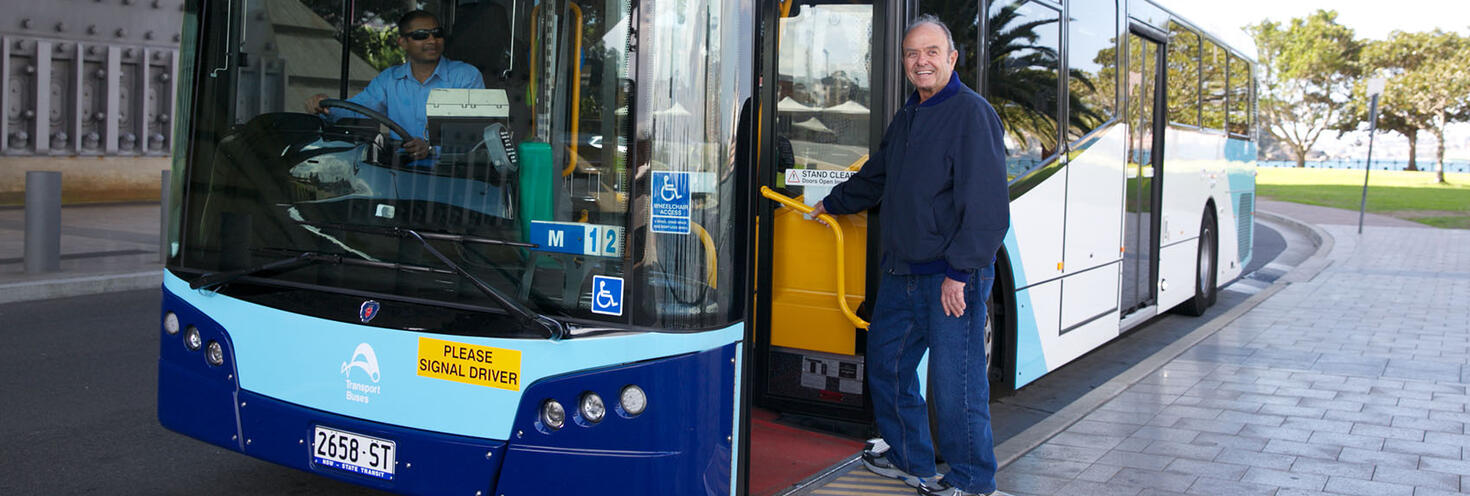Accessible bus travel

The majority of local bus services in NSW are accessible. If you have limited mobility, you can board and travel on most buses.
Planning an accessible trip with the Trip Planner shows you which bus services have accessible features. On printed bus timetables, look for the wheelchair accessible symbol or the letter a for accessible.
On rare occasions, due to operational requirements a non-accessible bus may be used to substitute accessible services.
Buses that are accessible have the wheelchair symbol displayed on the front of the bus. They have lower floors, wide doors, wide aisles and there are no steps in the front half of the bus. Other features include handrails, accessible stop buttons and highly-visible LED destination signs on the front the bus.
Accessible buses have designated areas with folded seats that are designed to fit mobility aids such as wheelchairs and ride-on scooters. These areas are also used for prams and strollers. However, wheelchair users and persons with limited mobility always have priority.
Wheelchair users can travel on non-accessible buses if they are able to leave their chair and get on and off the bus with or without the help of a companion.
The wheelchair must be folded and stowed away to keep aisles clear and allow other passengers to enter and leave the bus.
If you require assistance or the ramp to board the bus, position yourself in a safe spot where the driver can see you when waiting at the bus stop.
When boarding with your mobility aid
The bus driver will pull in close to the kerb, lower the bus and extend the accessible ramp. In most cases, you will board through the front door however on some buses it is the centre door that is accessible. The driver will let you know.
Park in the designated wheelchair space on the bus, facing towards the back. Ensure your mobility aid is out of the aisle and as close to the side of the bus as possible. The back of your wheelchair needs to be in firm contact with the panel or bar behind it and restrained, if restraints are available. Apply the wheelchair brakes once in position. The bus will not move until you are parked in the right direction with your wheelchair secured.
If travelling with a friend or carer, that person should keep a firm hold on the chair.
If the designated area is already full with passengers who have mobility aids, you will have to wait for the next service.
When approaching your stop, use the accessible bus stop button. This alerts the driver to pull in close to the kerb, and if required they will be ready to assist with the boarding ramp.
Read through the required mobility aids specifications before travelling.
When catching a bus with your mobility device, the driver can assist with
- lowering the bus and extending the ramp so you can get on and off
- asking other passengers to move so you can access the designated area
- service and trip planning information.
The driver cannot help you with
- the operation of your mobility aid
- the moving of your mobility aid, including lifting and carrying it
- your personal needs.
The driver is responsible for the safety and comfort of all customers on board so follow their instructions.
If necessary, the driver can ask you to leave the bus or not allow you to board the bus in the interest of the safety for all customers.
The driver may ask for prams, strollers, wheelchairs or other items to be stowed away to keep the aisle clear.
The driver will follow and apply the rules and they are not expected to pick up passengers with mobility aids if the bus has reached capacity.